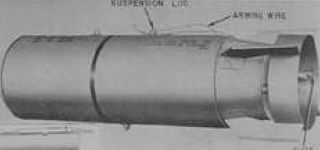Related Research Articles
The United States biological weapons program officially began in spring 1943 on orders from U.S. President Franklin D. Roosevelt. Research continued following World War II as the U.S. built up a large stockpile of biological agents and weapons. Over the course of its 27-year history, the program weaponized and stockpiled seven bio-agents — Bacillus anthracis (anthrax), Francisella tularensis (tularemia), Brucella spp (brucellosis), Coxiella burnetii (Q-fever), Venezuelan equine encephalitis virus, Botulinum toxin (botulism), and Staphylococcal enterotoxin B. The US also pursued basic research on many more bio-agents. Throughout its history, the U.S. bioweapons program was secret. It was later revealed that laboratory and field testing had been common. The official policy of the United States was first to deter the use of bio-weapons against U.S. forces and secondarily to retaliate if deterrence failed.

The M139 bomblet was an American sub-munition designed for use in warheads as a chemical cluster munition. Each spherical bomblet held 1.3 pounds (590 g) of sarin nerve agent.

The E120 bomblet was a biological cluster bomb sub-munition developed to disseminate a liquid biological agent. The E120 was developed by the United States in the early 1960s.
The M143 bomblet was a biological cluster bomb sub-munition developed by the United States during the 1960s. The spherical bomblet was the biological version of the Sarin-filled M139 chemical bomblet.

The M33 cluster bomb, also known as the (M33) Brucella cluster bomb, was a U.S. biological cluster bomb developed in the early 1950s and deployed in 1952. It was the first standardized biological weapon in the U.S. arsenal.

The M114 bomb was a four-pound U.S. anti-personnel bomb and biological cluster bomb sub-munition. The M114 was used in the M33 cluster bomb.

The Flettner rotor bomblet was a U.S. biological sub-munition that was never mass-produced. Based on the vertical Flettner rotor which takes advantage of the Magnus effect, a force acting on a spinning body in a moving airstream, it was developed toward the end of the U.S. biological weapons program in the 1960s.
The E77 balloon bomb was a U.S. anti-crop biological munition based on the design of Japanese Fu-Go balloon bomb. The E77 used feathers as a vector to disseminate anti-crop agents from a hydrogen-filled balloon and was first developed in 1950.

The M34 cluster bomb was the first mass-produced United States Army weapon meant to deliver the chemical agent sarin (GB). A large stockpile of M34s was destroyed between 1973 and 1976.
The M138 bomblet was a sub-munition of the U.S. chemical weapon, the M43 BZ cluster bomb. The bomblet contained BZ, an incapacitating agent and was developed with the M43 in 1962. The M138s, along with all other U.S. BZ weapons were destroyed during the 1980s.
The E14 munition was a cardboard sub-munition developed by the United States biological weapons program as an anti-crop weapon. In a series of field tests in 1955, the E14 was loaded with fleas and air-dropped.
The E86 cluster bomb was an American biological cluster bomb first developed in 1951. Though the U.S. military intended to procure 6,000 E86s, the program was halted in the first half of the 1950s.
The M125 bomblet was a U.S. chemical sub-munition designed to deliver the nerve agent sarin. It was brought into service in 1954 with the M34 cluster bomb as part of the first U.S. air-delivered nerve agent weapon.
The E133 cluster bomb was a U.S. biological weapon developed during the Cold War.
The E48 particulate bomb was a U.S. biological sub-munition designed during the 1950s for use with the E96 cluster bomb.
The Vigo Ordnance Plant, also known as the Vigo Chemical Plant or simply Vigo Plant, was a United States Army facility built in 1942 to produce conventional weapons. In 1944 it was converted to produce biological agents for the U.S. bio-weapons program. Although the plant never actually produced bio-weapons before the end of World War II, it did produce 8000 pounds of an anthrax simulant. After the war, the plant was transferred to Pfizer, who operated it until the plants closure in 2008.
Before the 20th century, the use of biological agents took three major forms:
Anthrax weaponization is the development and deployment of the bacterium Bacillus anthracis or, more commonly, its spore, as a biological weapon. As a biological weapon, anthrax has been used in biowarfare and bioterrorism since 1914. However, in 1975 the Biological Weapons Convention prohibited the "development, production and stockpiling" of biological weapons. It has since been used in bioterrorism.
References
- ↑ Whitby, Simon M. Biological Warfare Against Crops, (Google Books), Macmillan, 2002, pp. 114-15, ( ISBN 0333920856).
- 1 2 Endicott, Stephen Lyon and Hagerman, Edward. The United States and Biological Warfare: Secrets from the Early Cold War and Korea, (Google Books), Indiana University Press, 1998, p. 72, ( ISBN 0253334721).
- 1 2 3 4 5 Guillemin, Jeanne. Biological Weapons: From the Invention of State-Sponsored Programs to Contemporary Bioterrorism, (Google Books), Columbia University Press, 2005, p. 101, ( ISBN 0231129424).
- 1 2 3 Cirincione, Joseph. Deadly Arsenals:, (Google Books), APH, New Delhi: 2004, p. 60, ( ISBN 8176487325).
- 1 2 3 4 Chauhan, Sharad. Biological Weapons, (Google Books), APH, New Delhi: 2004, p. 197, ( ISBN 8176487325).
- 1 2 3 Smart, Jeffery K. Medical Aspects of Chemical and Biological Warfare Archived 2012-08-26 at the Wayback Machine : Chapter 2 - History of Chemical and Biological Warfare: An American Perspective, (PDF: p. 51 - p.43 in PDF), Borden Institute , Textbooks of Military Medicine, PDF via Maxwell-Gunter Air Force Base, accessed December 28, 2008.